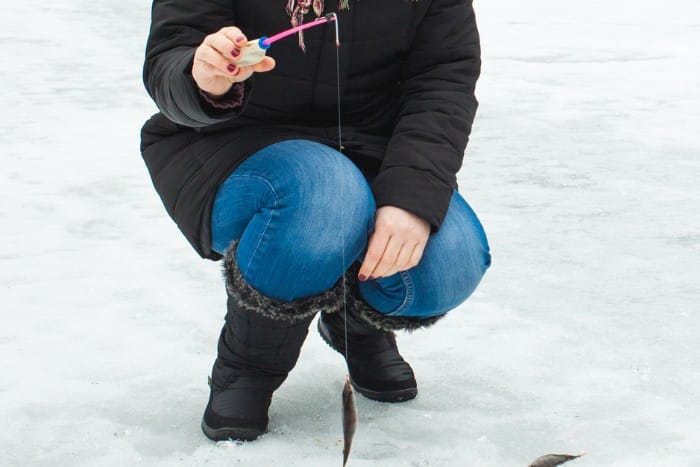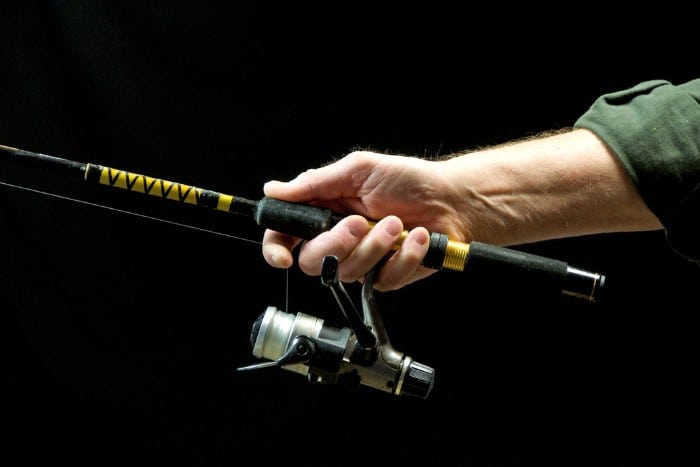Ice fishing is becoming more popular throughout North America as anglers are looking to fill The dead space that the colder months leave for fishing. Many first-time ice anglers are left with questions about what gear they need to hit the ice, including whether or not reels are necessary.
The short answer is no; you don’t need a reel for ice fishing, as hand lining and cane poles are viable options. Anglers also use spears to land fish through the ice. There are, however, benefits to using a reel when ice fishing, including the opportunity to fish faster and have a smooth retrieval.
Reels allow for a more thorough and complete fishing experience, but they aren’t an absolute necessity.
Do You Need a Reel for Ice Fishing?
There’s more than one way to skin a cat, and ice fishing is no different. Ice fishing can be done via hand lining or a cane pole without using a reel.
While these methods may seem archaic and minimalistic, they can be a fun way to hit the ice in search of fish for anglers looking for a challenge.
Handlining is one of the oldest fishing methods and requires skill and finesse to wrangle in even the smallest fish beneath the ice.
I also have another article on the best fishing methods for different types of fishing to help you increase your catch rate!
Cane poles are reminiscent of a Huckleberry Finn sequence of fishing, with anglers having nothing but a flexible branch and line between them and their quarry.
That said, there are many benefits to using a reel on the ice.
The addition of the reel makes for a smoother retrieval and the incorporation of equipment such as an ice fishing tip-up or a conventional rod and reel.
Know all about ice fishing tip-ups by clicking here.
Using a reel also means the opportunity to put out more than one line.
When using tip-ups or rod holders with flags, anglers can set out multiple lines in varying locations on the ice within eyeshot to increase their chances of hooking into a trophy fish.
How to Ice Fish without a Reel?
There are three main ways to ice fish without using a reel. These methods offer anglers a chance to return to some of the old-school techniques our ancestors used in the winter.
1. Hand Lining
Hand lining requires some line, tackle, and bait/lures. Anglers can work off a spool of line, or a pre-cut length with a hook and sinker on the end, in the form of either a lure or a bait setup.
The most hands-on of all the angling methods, this technique requires anglers to have their hands on the line at all times and removes the middle man, which is usually the rod and reel, meaning anglers have to get physical with the fish.
Anglers, with line in hand, will drop the bait or lure through the hole in the ice and feed out line from the spool or pre-cut length until it is at the proper depth.
Once it’s at the correct depth, it’s time to wait. When the fish take the hook, anglers must pull in the line with their hands, so gloves are recommended.
When hand lining, it’s recommended that anglers use a heavier pound test line as there is no drag or rod to help balance out the fish’s pull.

2. Cane Pole
Get back to the basics of fishing with the old-school setup of a cane pole.
When using a piece of bamboo or fiberglass rod, anglers will attach a line to the makeshift rod and drop the lure or bait down to the proper depth.
Although this method is more advanced than hand lining, it still requires skill and finesse from the anglers who have no drag or line to spool out from a reel.
This method is excellent for small to medium size fish, but without an excessive amount of line, anglers will have to be careful or run the risk of breaking the pole, their line, or losing the fish.
Cane Poles can be placed in rod holders and be used in conjunction with certain tip-ups and rod holders for a hands-off approach.
3. Spear Fishing
One of the final non-reel ice fishing methods is with a spear, which requires anglers to drill a larger hole in the ice with an ice saw or their auger.
Generally, anglers will do this inside a portable ice house to keep any of the outside light at bay. Darkness allows anglers to stare into the water and see fish swimming underneath them.
Once fish are in the open water beneath you, throwing the spear at the back of their heads will lead to a quick death and easy retrieval.
Some anglers will attach some rope or other type of chord to the spear and then attach it to their wrist in case it slips.
Types of Reels used for Ice Fishing
There are a couple of types of reels used in ice fishing: spinning and in-line reels.
1. Spinning Reels
Most spinning reels sized 1000-3000 will work well for anglers. Depending on the species you are after, the smaller the reel, the better because lighter tackle means smaller fishing line.
In the clear water beneath the ice, even the slightest silhouette of a line can stand out to wary fish. Many anglers will target walleye, pike, and other larger fish with a spinning reel.
They have a better drag system than in-line reels and can withstand some of those strong runs from heavy fish.
Spinning reels also do well when targeting panfish, so it truly is the most versatile option for ice fishing reels.

2. In-line Reels
In-line reels are meant for panfish. They have a similar style and feel to a fly reel. These are a free-spool type of reel, so you don’t have to deal with as much slack or line memory.
Your bait will fall directly into the water without any of those line twists. Panfish won’t be as skeptical of your bait as they might be with a spinning jig off of a spinning reel.
In-line reels are not suitable to use if you want to land some large pike or walleye.
Do check out my recommendations for the best ice fishing reels to buy one!
Necessary Features for Ice Fishing Reels
When purchasing a reel for “hard water” or ice fishing, it’s important to consider a few of the following.
Purpose
If you prefer jigging, select a reel that has good gear ratios for jigging or includes free spool buttons for dropping your jig.
Drag
A versatile drag is important for anglers who may fish for a variety of species.
Durability
Not only will you be around water in the conventional sense, but your reel will also be exposed to snow, ice, and other inclement weather that will degrade the reel’s integrity.
Invest in a quality reel that can handle the elements, and you won’t regret it.
Line
Find a reel that works with the pound test you plan to use in the water. Take the time and research your model to find what type of line and pound test works best with each reel.
Budget
The deciding factor is always budget. However, many reels come with bells and whistles you won’t need for everyday ice fishing. Find the model that works best for you and your wallet without the extra features.
Conclusion
Ice fishing without a reel can be fun and extra challenging. Hand-lining, cane poles, and spearfishing have their place in the ice fishing world.
It can be rewarding and quite fun to attempt to master these methods. Ice fishing reels allow you to properly present your baits and retrieve the fish in a safe and timely manner.
However, the advancements in ice fishing technologies are too hard to ignore. Do yourself a favor and purchase an ice fishing reel that fits your setup. The payoff will be well worth it.
